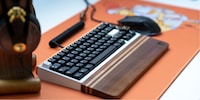
Background information
Why I spent 800 francs on a keyboard – and would do it again
by Kevin Hofer

For a long time now, I've been wishing for something more acoustic when typing my texts and the feeling of being able to press the keys down properly. When my Mac keyboard starts to squeak, I don't feel like it any more. I exchange it for a mechanical keyboard - homemade.
Daily I sit at the computer and miss something in the digital world: more haptics and three-dimensionality. Everything happens on the display. Even the devices themselves are getting flatter. As are keyboards. For me, this makes the devices lose personality - everything seems monotonous. When my iMac keyboard, which is only one year old, starts to squeak and jam, the case is clear: I want to be able to bang smoothly into the keys and be accompanied by a pleasant typing noise. A mechanical keyboard is needed.
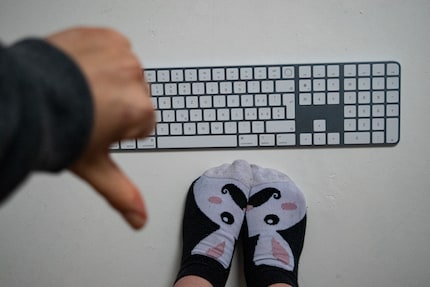
I like individual and colourful. After all the squeaking, I want a pleasant click-clack. Not too loud. I also don't want to use too much force to type. Can I influence that at all?
A lot of demands without know-how. But I know who I can turn to: Keycap Kevin, our in-house keyboard missionary, can help me.
My mission is music to Kevin's ears. Finally, a new disciple. He'll bring me a tactile and a linear keyboard to test, he says. Something depends on the switches, but I have to look at the layouts, because there are fewer keycaps for ISO and ... I don't understand anything at first.
.
So I read up and find out what I need for my custom keyboard. For my shopping list, I peek into Kevin's article. I need a case, PCB, top plate, switches, keycaps and a cable. What I need all the parts for, I have summarised for my further work.
My list:
When I get my hands on Kevin's keyboards, the first thing I notice is the weight. The case can be made of aluminium as well as plastic. Or made of wood. I myself want something that is handy and light. That way I can take the keyboard with me to the office.
With Kevin's keyboards, I notice that Ä, Ö and Ü are missing and Z and Y are reversed. He explains to me that this is due to the American ANSI layout. The European ISO variant has a different layout. With a saddle-fast ten-finger system, that's no problem - Kevin thinks. It bothers me. That's why I need a PCB with ISO layout. And RGB lighting, of course. For more in-depth info on layout, see here.
.
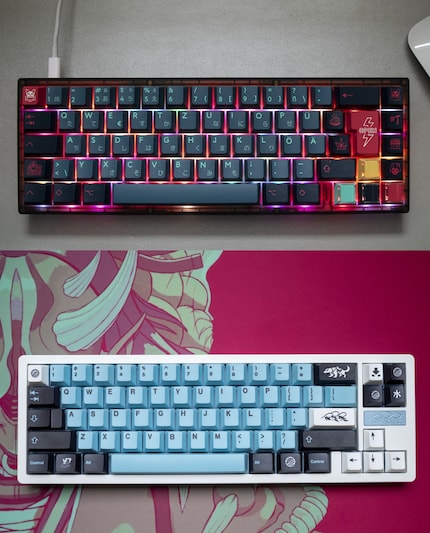
Kevin recommends a couple of keyboard parts suppliers to me. At Keygem I pick up a suitable case kit. It has the basics: case, PCB already soldered, a top plate, the stabilisers, a USB-C cable and a foam protector. I like black-transparent for my illuminated version, and plastic is light for travelling. Check. Still missing switches and keycaps.
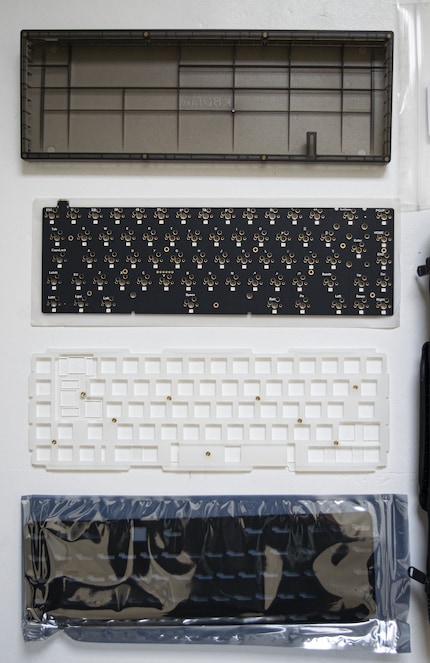
When typing on Kevin's various keyboards, I notice the differences in sound and resistance. This is because of the switches. With linear switches, I feel a keystroke, but I don't get any feedback on when the key triggers. With tactile ones, I can feel the trigger point from the changing resistance.
I find both appealing, but opt for the linear ones, which feel a bit more fluid. Within the linear category, there are differences in acoustics. Epsilon Switches have a deeper sound than, say, Tangerine. I'll go with the former. Lastly, Kevin recommends I use a grease to treat the stabilisers and switches. What stabilisers are, and can do, I'm still finding out.
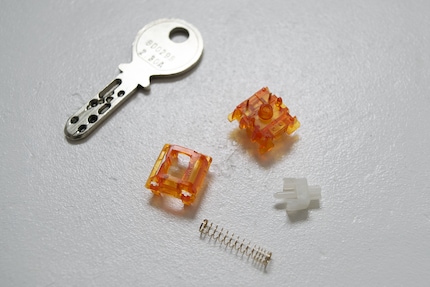
The keycaps took me the longest to choose. With cheerful naivety, I focused purely on looks, of course. They should be as colourful as possible. A unicorn must have puked on them. The usual. But I'm proven wrong: the type of plastic and the quality literally set the tone here, too. And I really only want one keyboard at home - a perfect one. So everything has to be right.
Kevin and I surf the web and find numerous keycap sets, none of which meet my requirements. Besides the quality, the price, and a colourful, special look, it also has to be in ISO layout. Or at least there must be complementary sets. More difficult than I thought. I'm on the verge of buying a plain white set to just paint it myself. But then I land on Candykeys. Many of their colourful sets are unfortunately sold out. But I find one that meets all my wishes. Even Kevin is jealous! Let's hope the 160 francs for the keycaps alone pays off.
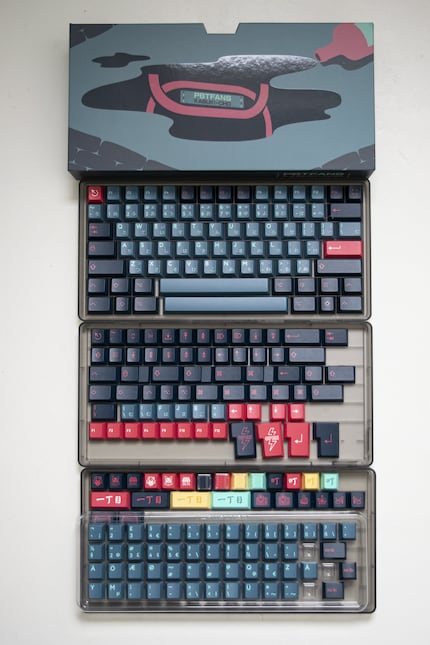
With this, the puzzle is complete. Now it's time to assemble. Besides the helpful information from Kevin, I have a second, extremely relevant resource for this: Youtube. There I get step-by-step instructions on all the stages of building my keyboard.
Since "lubing" (greasing) the stabilisers seems to be pretty much the most important point, I devote myself to that first. I follow this video tutorial.
I already notice that I am missing one or the other tool at this step, though. For applying the lubricant inside the stabilisers, I need a disposable syringe with a wide enough nozzle. I confused three pharmacists and a building supplies employee with my wish for such a syringe. But I found what I was looking for at the last pharmacy.
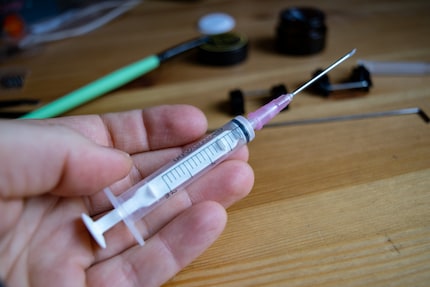
The work seems enormous to me. I have to pull apart almost 70 switches and grease them with a small brush. To determine the difference in acoustics and typing feel, I first try it out on one part. I watch a Youtube video to see how I open the switches with tweezers. Pros would have a switch opener for that.
In fact, it's worth the effort and I get over myself to work all the switches. In doing so, I realise the meditative nature of this step. I have thus integrated the luben of the switches into my coffee morning routine. In hindsight, I almost miss it a bit ...
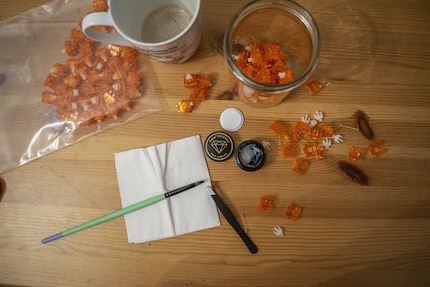
I set about putting the pieces together. A further video shows me which parts go where. It's a lot easier than puzzling around if you've never done it before.
Just before putting on my keycaps, I figure this will be the easiest and most fun part. Fun? Yep. Easy? Well. I put the difficulty on myself because I want to get as close as possible to the Swiss keyboard layout. Unfortunately, not all the keycaps on offer match.
But there are some funny illustrations with drinks, cat heads and even a steak. Therefore, I get creative and put the alcoholic drinks as a substitute for the dollar sign, for example, and the steak for my non-existent exclamation mark. Because each row of keycaps in my set has a different height and slope, I have to think twice. In the end, I am satisfied.
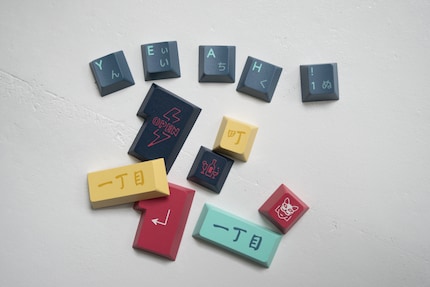
Excited, I connect the keyboard to my Mac and hope for the best. Lo and behold, my custom keyboard begins to happily glow away.
I can only change the RGB mode when I use the program VIA to convert a key into an Fn key. I can then use the Fn-W key combination to set the desired lighting. This is the last step I need to do for my self-assembled keyboard.
In a nutshell: The work was worth it. I really like the acoustics of my new keyboard. The colourful keys and the lighting enhance my work and I really enjoy using it to finish this text. Moreover, it's an absolute feeling of happiness to have put something together myself.
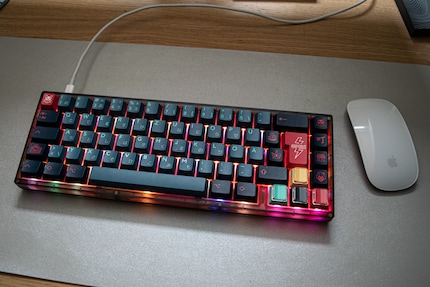
The best point is the fact of having learned something new again. It definitely enriched me, even if I probably need some "space" before the next custom keyboard.
Titelfoto: Michelle Brändle
In my world, Super Mario chases Stormtroopers with a unicorn and Harley Quinn mixes cocktails for Eddie and Peter at the beach bar. Wherever I can live out my creativity, my fingers tingle. Or maybe it's because nothing flows through my veins but chocolate, glitter and coffee.
Interesting facts about products, behind-the-scenes looks at manufacturers and deep-dives on interesting people.
Show all